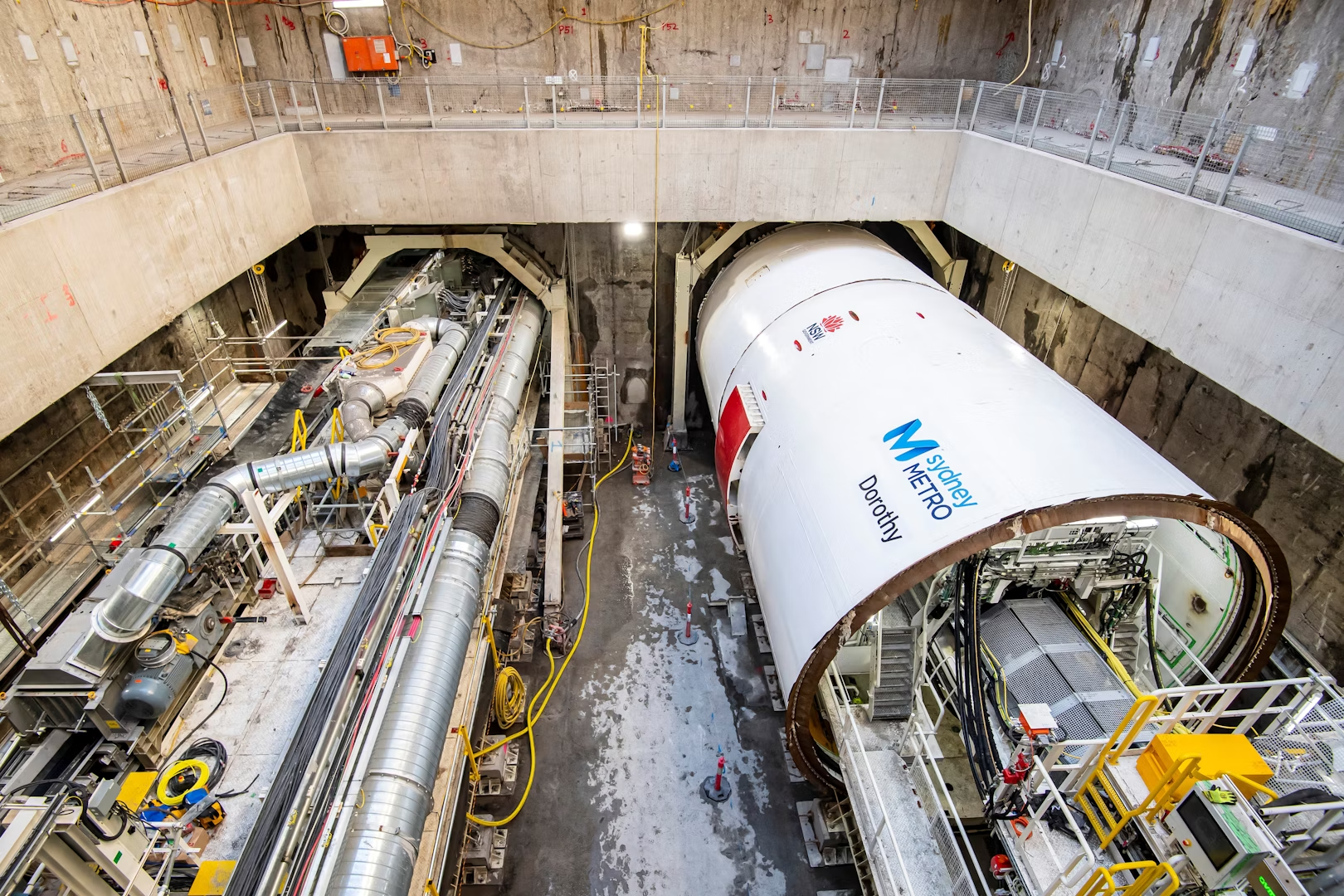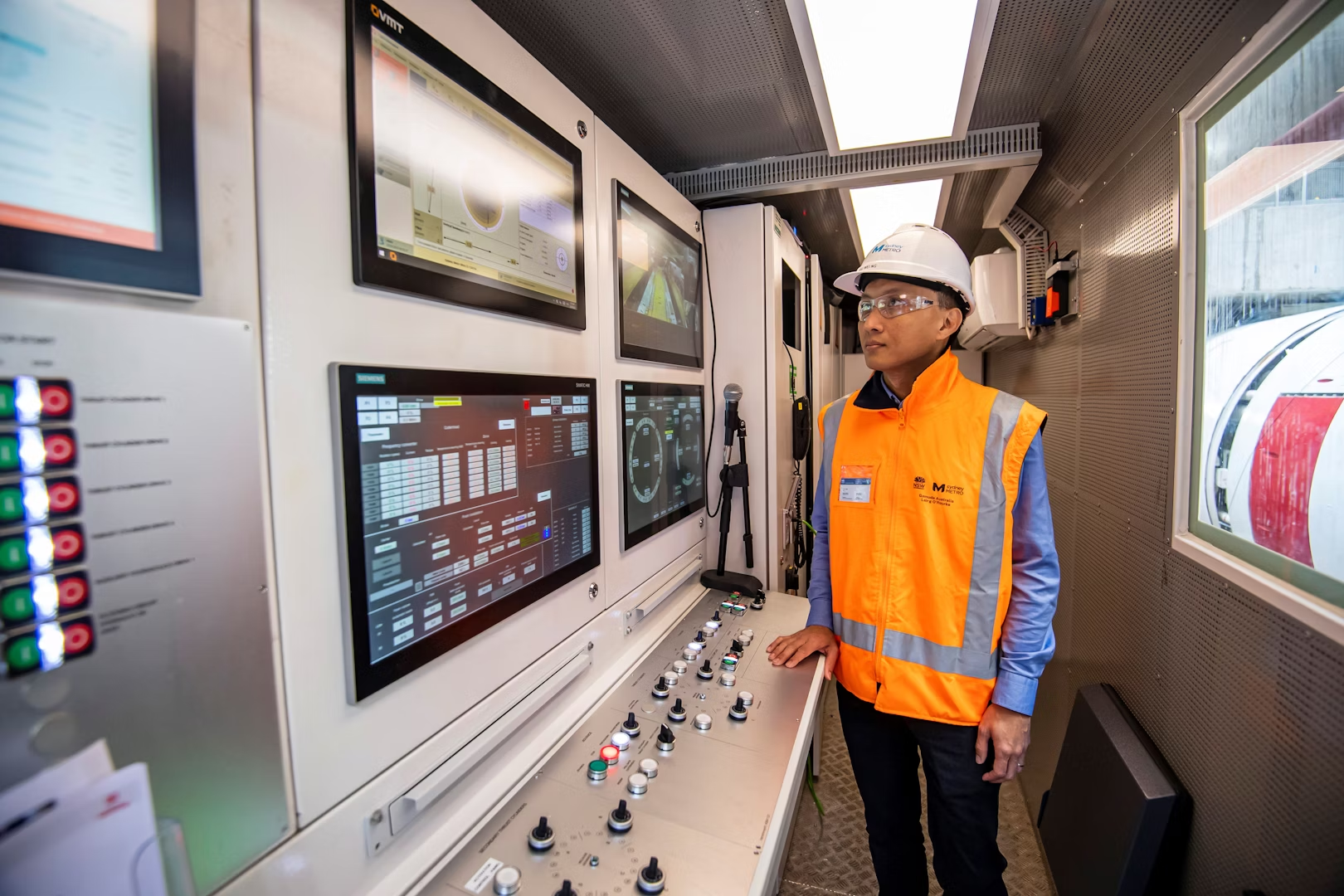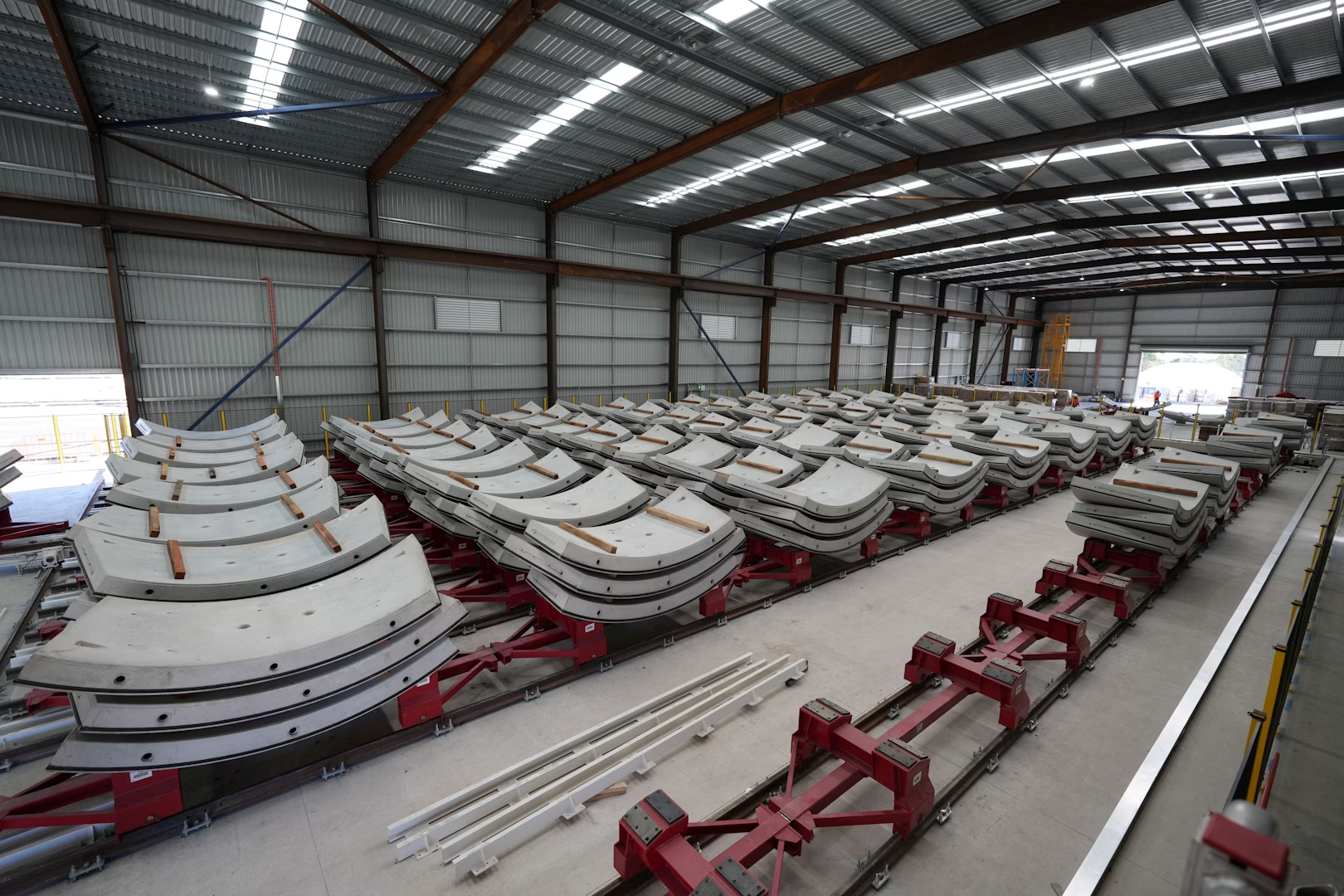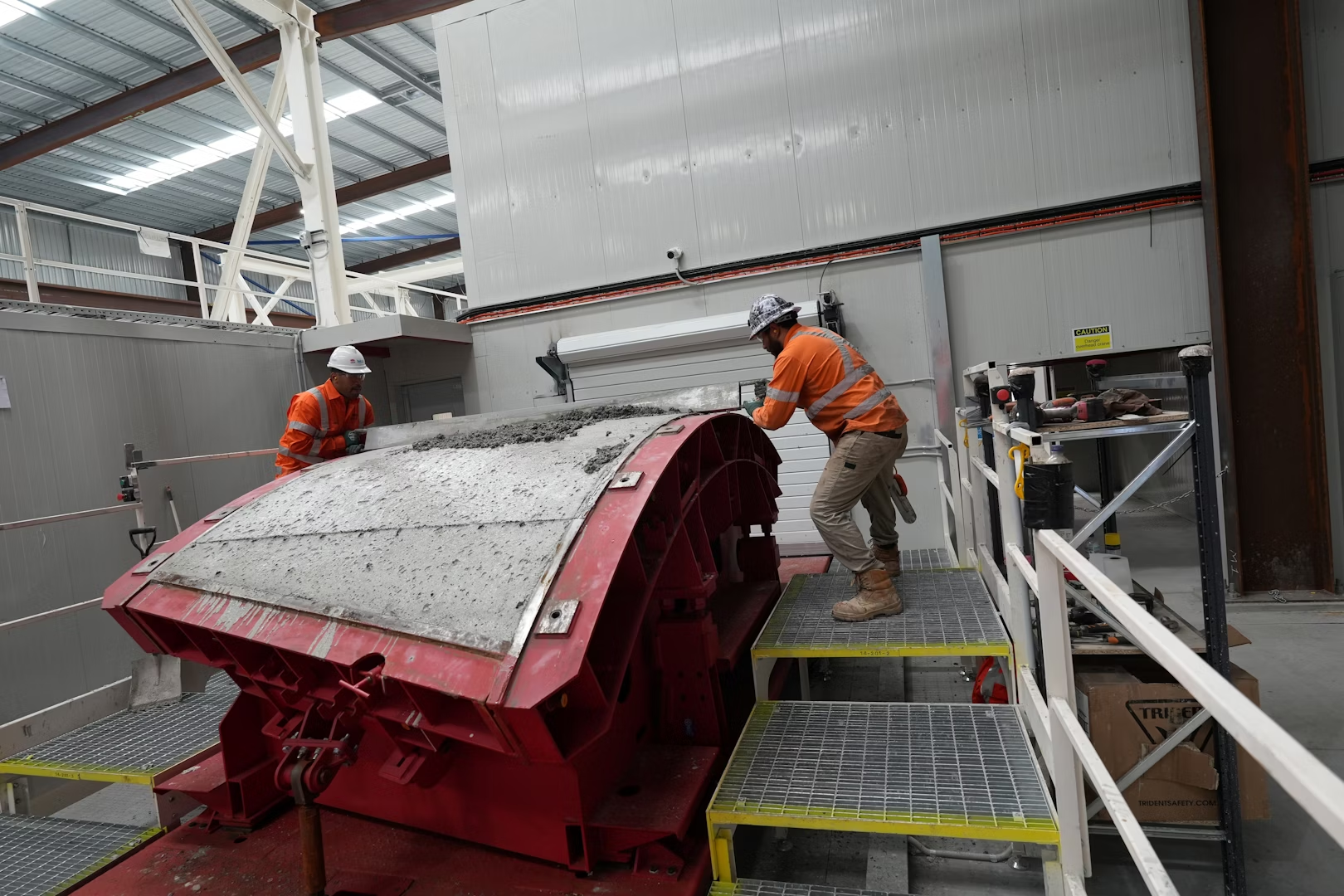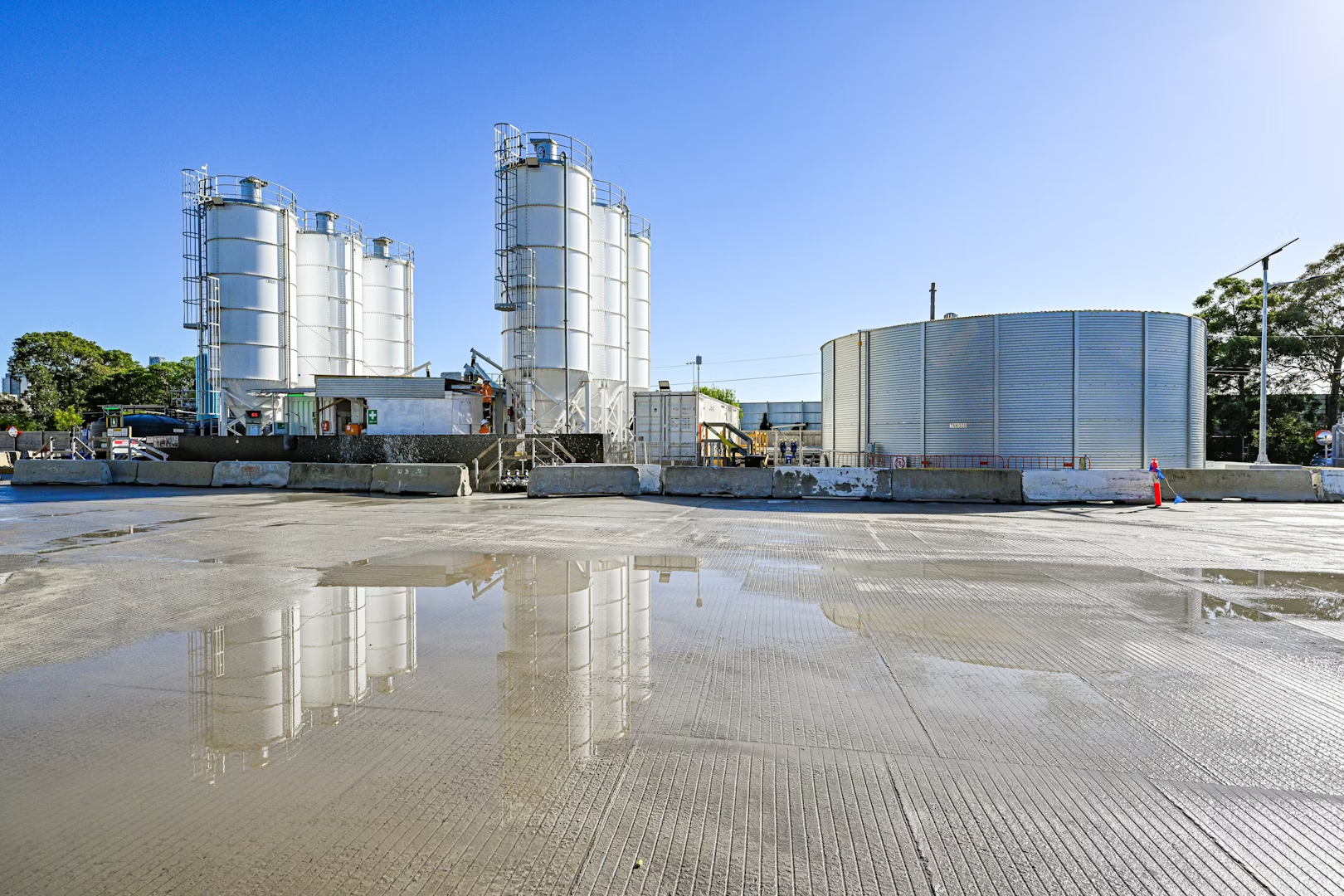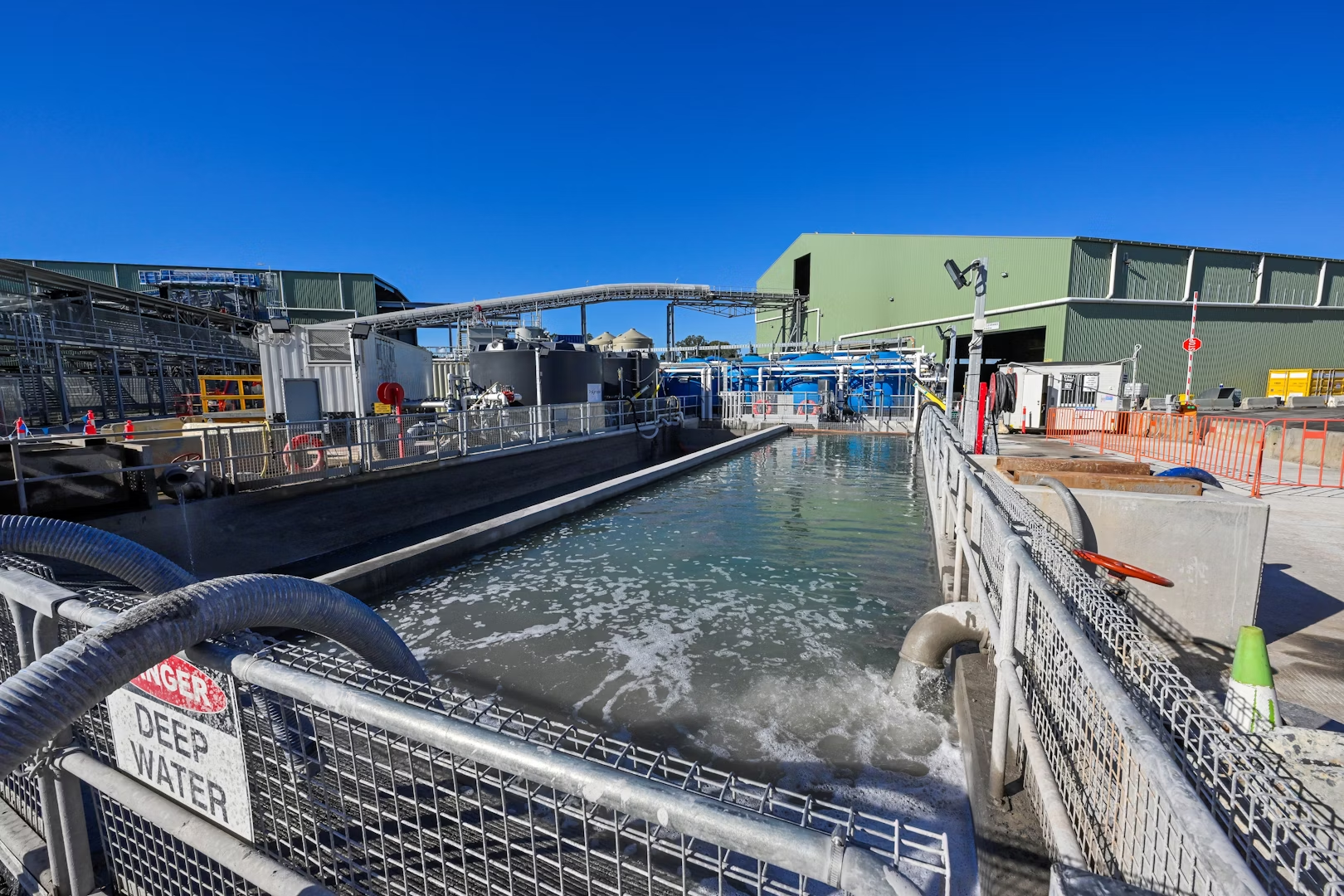Sydney Metro West – Western Tunnelling Package – Environmental Outcomes
The Gamuda and Laing O’Rourke Consortium’s Sydney Metro West – Western Tunnelling Package project has pioneered three significant innovations, leading to a more sustainable tunnelling operation:
• Australia’s First Autonomous Tunnelling Boring Machine (A-TBM): Implementing AI-driven autonomous operation, minimising human intervention whilst achieving an 8% energy saving compared to manual TBMs.
• 100% Recycled Water for TBM Operations: Collaborating with Herrenknecht, the Rosehill Water Treatment Plant treats groundwater and rainwater to meet TBM needs and NSW Environmental Protection Authority (EPA) standards, ensuring complete water recycling.
• Industry-Transformative Precast Segment Mix: Developing an industry transformative precast tunnel segment mix with 50% supplementary cementitious material (SCM), an Australian first in precast tunnelling segment production. Meeting Sydney Metro’s aspirations, this expectation is now extended to delivery partners across other Sydney Metro projects.
Describe WHAT you have done and HOW you have done it. Please provide a summary of your initiative, innovation, or approach.
The Gamuda and Laing O’Rourke Consortium (GLC) is delivering the Sydney Metro West - Western Tunnelling Package (WTP). The project showcases a groundbreaking approach to tunnel construction, addressing key environmental challenges. Our approach has yielded three innovations across the usage of energy, water and materials.
• Autonomous Tunnel Boring Machines (A-TBMs) – energy savings
WTP is the first in Australia to implement an A-TBM, previously proven on Malaysia’s KVMRT Line 2 project as a world first. This technology utilises advanced sensors, control systems, and artificial intelligence (AI) for autonomous operation, minimising manual handling whilst maximising efficiency. A comparative study of the A-TBM against manual TBMs has been conducted by GLC’s tunnelling engineers on WTP. The study revealed substantial energy savings, improved steering accuracy, and increased productivity, solidifying the technology’s benefits in a market that has traditionally seen the use of manually operated TBMs.
• Treated water feeding all A-TBM operations – potable water savings
The use of treated groundwater for all TBM operations has historically been difficult to implement. TBMs have strict water quality requirements, and have significant operational and associated production risks, so the drivers to innovate in this space have been historically low. In addition, mains supplied potable water is reliable, consistent, and cheap (~$2.70/kL).
In collaboration with the world’s largest TBM manufacturer, Herrenknecht, GLC designed and commissioned the Rosehill Water Treatment Plant. The plant captures and treats groundwater and rainwater to meet the A-TBMs water quality and operational volume requirements and the NSW Environmental Protection Authority (EPA) water quality discharge specifications. The robust groundwater treatment process ensures that the water quality and operational volume consistently meets the requirements for the A-TBM’s water demands. GLC’s use of treated water for all A-TBM operations saves a substantial amount of potable water, setting a new benchmark for sustainable water management in tunnelling operations.
• Industry transformative concrete mix for precast tunnel lining segments – material usage savings
To meet the industry leading sustainability challenge set by Sydney Metro, GLC collaborated with Boral to develop a precast tunnel segment mix with 50% supplementary cementitious material (SCM), an Australian first in precast tunnelling segment production. This mix, also containing 10% less cementitious material compared to traditional mixes of similar strength, is a market first for high-speed carousel production, setting a new standard for sustainable concrete mixes in tunnelling. Notably, the mix also incorporates 50% manufactured sand, a feat previously not achieved in tunnel projects utilising precast segment lining.
GLC and Boral’s achievement of a 50% SCM mix (and all associated results) proved the viability of Sydney Metro’s aspirations, who then extended that expectation to how delivery partners approach SCM rates in their concrete across other Sydney Metro projects.
GLC’s collaborative approach significantly reduces the environmental impact associated with energy, water and materials consumption on the WTP tunnelling works. Whilst driving sustainable construction practices, this innovative approach demonstrates a significant advancement in the Australian tunnelling industry. By integrating autonomous technology, sustainable water management, and low-carbon materials, GLC has met and set new standards for efficient, environmentally responsible tunnelling practices.
What were the OUTCOMES and how were those outcomes shared?
GLC’s innovative approach has yielded tangible benefits of integrating advanced technologies and sustainable practices into a complex tunnelling project. These outcomes has influenced industry standards and set new benchmarks for environmental responsibility and efficiency in infrastructure construction.
• Autonomous Tunnel Boring Machines (A-TBMs) – energy savings
Traditionally, skilled TBM operators navigate the TBM along the designed tunnel axis (DTA) as determined by tunnel surveyors. The introduction of autonomous functionality in TBMs requires a maximum deviation from the DTA to just ±5mm. This ensures a high-quality tunnel finish and prevents unnecessary deviations, and slower mining progress which consumes more time and energy.
The A-TBM’s energy efficiency has been demonstrated in the Australian context through a comparative performance experiment between the A-TBM and manually operating TBM on WTP. The experiment was undertaken for a fair and robust comparison between the two types of TBM operations. A-TBM operation was compared with a manually operated TBM within the same chainage of the tunnel alignment, ensuring that both had the same steering radius and encountered identical geological conditions. The study found that the A-TBM was 8% more efficient compared to a manually operated TBM. As the two A-TBM’s are significant end users of electricity on WTP, estimated to account for ~30% of all electricity used on WTP, a saving of 8% equates to 560MWh of electricity saved. Based on the July-2023 to June-2024 reporting period only, the saving is 198 tCO2eq abated compared to a manually operated TBM.
• Treated water to feed all TBM operations – potable water savings
By treating rainwater and groundwater inflows and reusing them for tunnelling operations, GLC has conserved 109,000kL of potable water through the reuse of non-potable (treated) water, of which 90,000kL falls within the July-2023 to June-2024 reporting period. This achievement has not only reduced WTP’s environmental impact and reliance on a finite resource, but demonstrates that through collaboration and upfront capital investment, alternative water sources can be successfully utilised on large-scale tunnel construction projects. The sheer scale of this initiative is unprecedented. As endorsed by Herrenknecht, the world’s largest manufacturer and supplier of TBMs, treated groundwater has never been used to supply tunnelling operations in any of their TBM’s in Australia. Sydney Metro has confirmed that no previous tunnelling contractor across their projects has done this before, a first in NSW.
• Industry transformative concrete mix for precast tunnel lining segments – material usage savings
GLC collaborated with Boral and Sydney Metro to develop and implement a 50% SCM precast concrete tunnel segment mix, which significantly reduced WTP’s embodied carbon footprint. The key material of concrete, cement, releases high amounts of CO2 during its production process. Therefore, it is imperative for sustainable construction to use cement alternatives in concrete production.
The 50% SCM concrete mix, along with Boral’s ZEP additive, meets and exceeds Sydney Metro’s progressive benchmark for sustainable precast concrete production in the Australian tunnelling industry. Compared to the industry standard, the use of Boral’s Envisia mix with 50% SCM replacement equated to a carbon saving of ~6,070tCO2eq during the July-2023 to June-2024 reporting period alone with 11,221t of cement replaced. With only half of the segments produced, the total savings from this industry transforming mix will equate to approximately 12,000 tCO2eq abated, significantly contributing to the fight against climate change. Additionally, the incorporation of 50% manufactured sand in the mix has demonstrated the potential for utilising alternative materials in precast concrete production, reducing the demand for natural resource usage.
The proof of Sydney Metro’s concept of high SCM, low carbon concrete, has prompted other major projects, the Eastern Tunnelling Package (ETP), and the Western Harbour Tunnel (WHT), to adopt similarly sustainable mixes. ETP’s Project Director formally reached out to GLC to explore the benefits of the precast concrete mix design. Additionally, Boral has confirmed that this mix is now being supplied to ETP and is under consideration for use in the WHT project.
These initiatives alone will save 560MWh of electricity, 109,000kL of water, and more than 12,000tCO2eq of carbon emissions. The outcomes of these innovations represent the transformative power of collaboration. By embracing advanced global technologies, sustainable practices, and a commitment to knowledge sharing, GLC is pushing the boundary of sustainable and efficient construction within the Australian tunnelling industry.
Describe WHO benefited from your initiative, innovation, or approach?
First and foremost, this wholistic approach represents our project team’s commitment to addressing climate change by consuming less power and lowering our carbon footprint to benefit our planet, our community and future generations.
The Environment:
Our planet directly benefits from GLC’s approach. Given the significant role of the construction industry in global carbon emissions, this reduction in carbon emissions is a tangible contribution to mitigating climate change. The reduction in cement usage in the precast segment mix and reduced electricity usage from the A-TBM’s diminishes WTP’s carbon footprint. Moreover, the conservation of 90,000kL of potable water, a scarce resource across Australia, showcases WTP’s commitment to environmental stewardship and social consciousness.
The Industry:
The wider construction and tunnelling industry have benefited from GLC’s innovations, which drive the industry to improve existing practices and adapt to new technologies. The implementation of the A-TBM and the demonstration of its efficiency have set a new standard for tunnel construction in Australia, particularly as advancements in AI continue to revolutionise industries worldwide. By minimising human error and optimising decision-making processes, AI-powered systems like the A-TBM can significantly enhance the speed and precision of tunnel construction. The demonstrable improvements in the A-TBM’s performance will encourage wider adoption of this technology, driving improvements in the industry and leading to more efficient and sustainable projects in Australia.
GLC’s collaboration with Boral to produce the “Envisia” mix with 50% SCM replacement, has set a new benchmark for sustainable concrete segment mix production in Australia. The substantial carbon savings achieved through this mix, estimated to be over 12,000 tCO2eq across all produced segments, have already influenced other projects, fostering a broader shift towards low-carbon construction materials.
In an industry first, through the re-use of non-potable water in TBM operations, GLC has set a new standard for what is possible in tunnel construction. This has never been achieved and ensures a lower impact to Western Sydney’s potable water supply.
The Local Community and Future Generations:
GLC’s sustainable tunnelling approach also benefits the local community and future generations. The project’s reduced environmental impact contributes to a healthier and more sustainable living environment. The conservation of potable water ensures a more reliable supply for the community, particularly in times of drought or increased demand. GLC’s focus on innovation and knowledge sharing fosters a culture of continuous improvement and development within the industry, paving the way for a more resilient future.
What LEGACY and UN SDG CONTRIBUTION was achieved?
The strong collaboration and knowledge sharing on WTP has established a legacy of groundbreaking environmental outcomes in the Australian tunnelling industry. By working with our Malaysian counterparts, we introduced the innovative use of A-TBMs, significantly advancing energy efficiency and setting new standards for sustainable tunnelling. Our partnership with Herrenknecht proved that treated water could be effectively reused in all TBM operations, marking a breakthrough in sustainable water management. Additionally, the combined effort of Sydney Metro’s dedication, GLC’s expertise, and Boral’s ingenuity led to the creation of a 50% SCM precast tunnel segment, pushing the boundaries of low-carbon concrete technology. These initiatives have not only challenged the current limits of the Australian tunnelling industry but have also set new benchmarks for all future projects. The legacy of these environmental outcomes demonstrates the powerful impact of collaboration and a strong commitment to sustainability, setting a precedent for future industry practices.
UN SDG 6: Clean Water and Sanitation: Ensure availability and sustainable management of water and sanitation for all.
WTP’s use of treated groundwater for A-TBM operations directly addresses this goal by ensuring the availability and sustainable management of water. This initiative has significantly reduced the WTP’s reliance on Western Sydney’s potable water supply, a critical resource in an era of increasing water scarcity. This initiative not only conserves valuable water resources but also sets a precedent for sustainable water management in the construction industry, demonstrating that large-scale projects can operate with minimal impact on local water supplies, especially in an urban environment.
UN SDG 9: Industry, Innovation, and Infrastructure: Build resilient infrastructure, promote inclusive and sustainable industrialization and foster innovation.
WTP’s implementation of the A-TBM technology and the high SCM precast segment mix exemplifies this goal by showcasing the benefits of innovation. The A-TBM’s utilisation of advanced AI and automation technology showcases the transformative potential of digital innovation in the construction sector. This technology not only improves efficiency and productivity but also enhances safety and reduces the environmental impact of tunnel construction. Similarly, the development of the high SCM precast segment mix demonstrates a commitment to innovative materials for a responsible infrastructure. The successful implementation and testing of this mix on WTP has paved the way for its adoption in other major projects like the ETP project who uses a similar mix based on the concrete mix design provided to the project by GLC.
UN SDG 12: Responsible Consumption and Production: Ensure sustainable consumption and production patterns.
The use of treated water for A-TBM operations, the reduction in cement use in the precast segment mix, and the incorporation of manufactured sand all contribute to a more responsible and sustainable approach to resource utilisation. These practices not only minimise WTP’s environmental impact but also demonstrate the feasibility of circular economy principles in the construction industry.
UN SDG 13: Climate Action: Take urgent action to combat climate change and its impacts.
GLC’s contribution to SDG13 includes reducing our greenhouse gas emissions through energy efficiency measures such as the use of the A-TBM, and substitution measures such as cement replacement. WTP’s emphasis on sustainable practices sets an example for the industry, as we demonstrate that critical infrastructure projects can be delivered without sacrificing development and prosperity for people and planet. Already, GLC has seen our influence on the industry through ETP’s uptake on their high SCM precast concrete mix.
GLC has answered the UN’s call to action by showing how critical development infrastructure can be built while tackling climate change and conserving our natural resources through innovation and collaboration.


